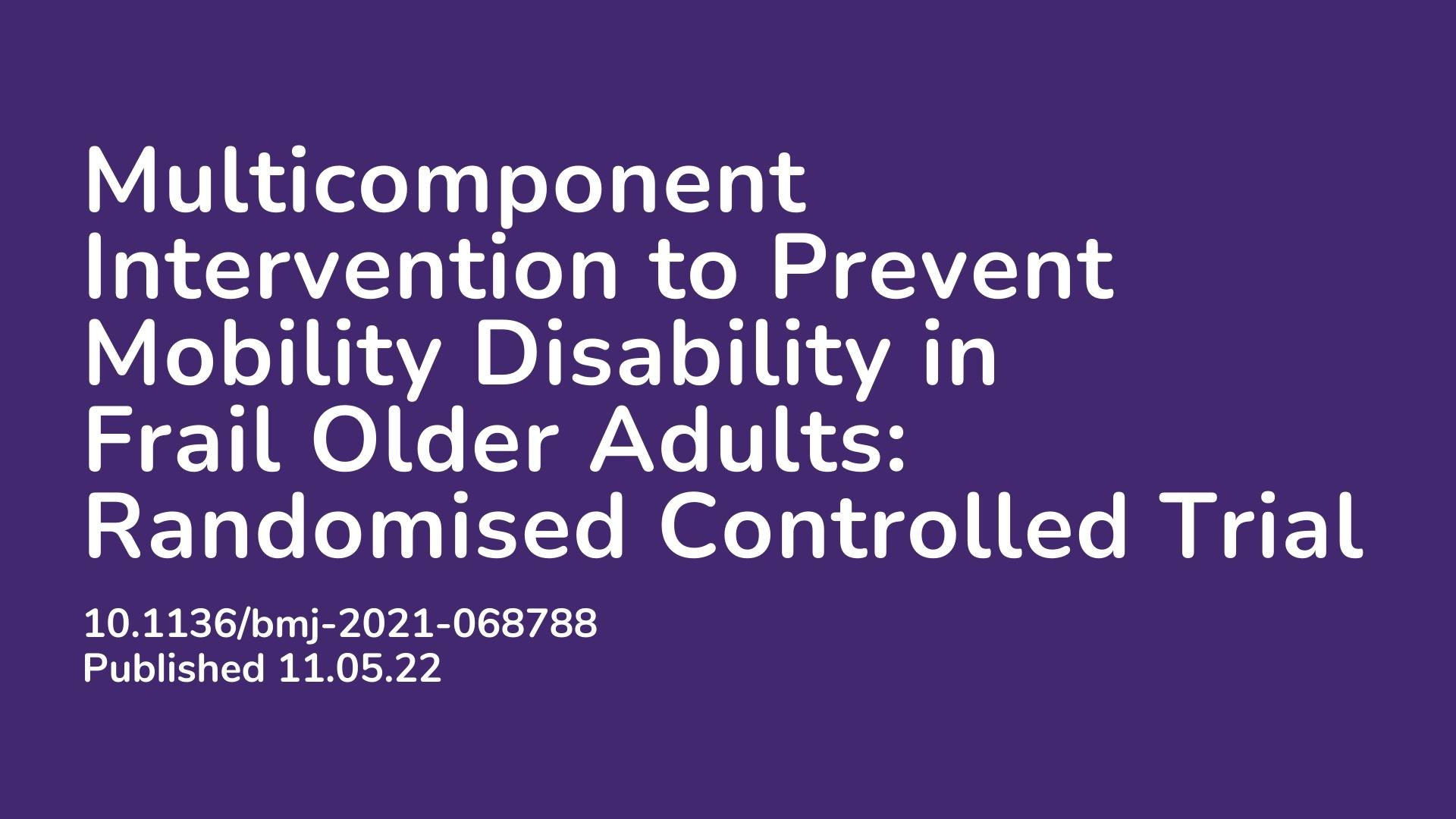Summary: The objective of this randomised controlled trial (RCT) is to determine whether a mixed modality approach based on physical activity and tracking nutritional parameters prevents mobility disability in patients with age related physical frailty and sarcopenia.
1519 men and women aged 70 years or older were included in the study. 760 participants were randomised to the multi-component intervention consisting of physical activity and nutrition counselling and 759 received education on healthy ageing (the control group). The control participants received education on healthy ageing once a month. The primary outcome of this RCT was to determine the level of mobility disability – measured as the inability to independently walk 400 metres in less than 15 minutes without stopping for more than one minute, sitting or requiring help from a person or walking aid. The nutrition component was designed to complement the physical activity program and involved tailored nutritional assessments and prescription with two main targets: an appropriate daily energy intake and a daily protein intake of at least 1.0-1.2 g/kg body weight.
This RCT concluded that interventions based on physical activity and tailored nutrition advice in participants with physical frailty and sarcopenia was associated with a reduction in mobility disability, compared with lifestyle education alone. Given that the number of age related conditions cause significant strain on both a patient as well as the healthcare system, safe, effective interventions that reduce risk factors of frailty and sarcopenia are needed as a standard and primary recommendation for best practice. More longer term studies in this area will support the inclusion of physical activity and nutrition in the treatment and prevention of age related ailments.
Abstract:
Objective: To determine whether a multicomponent intervention based on physical activity with technological support and nutritional counselling prevents mobility disability in older adults with physical frailty and sarcopenia.
Design: Evaluator blinded, randomised controlled trial.
Setting:16 clinical sites across 11 European countries, January 2016 to 31 October 2019.
Participants: 1519 community dwelling men and women aged 70 years or older with physical frailty and sarcopenia, operationalised as the co-occurrence of low functional status, defined as a short physical performance battery (SPPB) score of 3 to 9, low appendicular lean mass, and ability to independently walk 400 m. 760 participants were randomised to a multicomponent intervention and 759 received education on healthy ageing (controls).
Interventions: The multicomponent intervention comprised moderate intensity physical activity twice weekly at a centre and up to four times weekly at home. Actimetry data were used to tailor the intervention. Participants also received personalised nutritional counselling. Control participants received education on healthy ageing once a month. Interventions and follow-up lasted for up to 36 months.
Main outcome measures: The primary outcome was mobility disability (inability to independently walk 400 m in <15 minutes). Persistent mobility disability (inability to walk 400 m on two consecutive occasions) and changes from baseline to 24 and 36 months in physical performance, muscle strength, and appendicular lean mass were analysed as pre-planned secondary outcomes. Primary comparisons were conducted in participants with baseline SPPB scores of 3-7 (n=1205). Those with SPPB scores of 8 or 9 (n=314) were analysed separately for exploratory purposes.
Results: Mean age of the 1519 participants (1088 women) was 78.9 (standard deviation 5.8) years. The average follow-up was 26.4 (SD 9.5) months. Among participants with SPPB scores of 3-7, mobility disability occurred in 283/605 (46.8%) assigned to the multicomponent intervention and 316/600 (52.7%) controls (hazard ratio 0.78, 95% confidence interval 0.67 to 0.92; P=0.005). Persistent mobility disability occurred in 127/605 (21.0%) participants assigned to the multicomponent intervention and 150/600 (25.0%) controls (0.79, 0.62 to 1.01; P=0.06). The between group difference in SPPB score was 0.8 points (95% confidence interval 0.5 to 1.1 points; P<0.001) and 1.0 point (95% confidence interval 0.5 to 1.6 points; P<0.001) in favour of the multicomponent intervention at 24 and 36 months, respectively. The decline in handgrip strength at 24 months was smaller in women assigned to the multicomponent intervention than to control (0.9 kg, 95% confidence interval 0.1 to 1.6 kg; P=0.028). Women in the multicomponent intervention arm lost 0.24 kg and 0.49 kg less appendicular lean mass than controls at 24 months (95% confidence interval 0.10 to 0.39 kg; P<0.001) and 36 months (0.26 to 0.73 kg; P<0.001), respectively. Serious adverse events occurred in 237/605 (39.2%) participants assigned to the multicomponent intervention and 216/600 (36.0%) controls (risk ratio 1.09, 95% confidence interval 0.94 to 1.26). In participants with SPPB scores of 8 or 9, mobility disability occurred in 46/155 (29.7%) in the multicomponent intervention and 38/159 (23.9%) controls (hazard ratio 1.25, 95% confidence interval 0.79 to 1.95; P=0.34).
Conclusions: A multicomponent intervention was associated with a reduction in the incidence of mobility disability in older adults with physical frailty and sarcopenia and SPPB scores of 3-7. Physical frailty and sarcopenia may be targeted to preserve mobility in vulnerable older people.
Article Publication Date: qq.05.22
DOI: 10.1136/bmj-2021-068788



